Physical Address
304 North Cardinal St.
Dorchester Center, MA 02124
| Definition |
|
| Prevalence |
|
| Genetic risk |
|
| Cognitive symptoms |
|
| Diagnostic criteria |
|
| Behavioral symptoms |
|
| Treatment |
|
| Top differential diagnoses |
|
(See Chapter 2, Chapter 2 for additional information.)
An 84-year-old woman was brought in by her daughter for slowly deteriorating thinking and memory over five years. Her phone was disconnected because she forgot to pay the bills, and there was spoiled food in the refrigerator. When interviewed she had pauses in her speech and her daughter often filled in missing words for her. She was not oriented to the day, date, month, or year, nor could she name several common items or recall them a few minutes later. A computed tomography (CT) scan of the head showed an average amount of small vessel ischemic disease for her age (see Chapter 7 ) and atrophy of hippocampi, temporal lobes, and parietal lobes.
A 78-year-old man and his wife were both concerned that his memory was not as good as it was last year. He used to be able to remember a short grocery list in his head, but now he needed to write it down or he would return with the wrong items. He continued to pay the bills, balance the checkbook, and do household projects, although these tasks now took him longer to complete. Evaluation of memory testing in the office showed that he scored below normal when repeating a brief story containing ten details. His laboratory data were unremarkable, and his magnetic resonance imaging (MRI) scan showed bilateral atrophy in hippocampi, temporal lobes, and parietal lobes.
Both of these patients show a characteristic pattern of symptoms, cognitive testing, and structural brain imaging suggestive of Alzheimer’s disease, the first consistent with Alzheimer’s disease dementia, the second consistent with mild cognitive impairment (MCI) due to Alzheimer’s disease.
Alzheimer’s disease is a neurodegenerative disease of the brain typically characterized by a prominent memory impairment and having a specific pathology including senile plaques and neurofibrillary tangles ( ). Over time, Alzheimer’s disease produces neurochemical deficits and prominent brain atrophy. Alzheimer’s disease is by far the most common cause of dementia, either by itself or in combination with other disorders. Although the exact prevalence is difficult to ascertain, it is estimated that approximately 5.8 million Americans are living with Alzheimer’s disease dementia. The overall prevalence of Alzheimer’s disease dementia in the community is estimated at about 10% in population-based studies. Although there are approximately 200,000 Americans under age 65 living with Alzheimer’s, the disease becomes more prevalent with age, with most cases being diagnosed after the age of 65. It is estimated that approximately 3% of people aged 65 to 74 years, 17% of people aged 75 to 84 years, and 32% of people aged 85 years and older have Alzheimer’s disease dementia. Worldwide, it is estimated that 50 million people have dementia, comprising 5% of the world’s population over age 60 ( ). Because the population is aging, the number of individuals with Alzheimer’s disease is rapidly rising ( Figs. 4.1–4.4 ). Approximately two-thirds of patients with Alzheimer’s disease are women, with the overall lifetime risk being 11.6% for men and 21.1% for women. The incidence of Alzheimer’s disease is lower in Asian Americans and higher in American blacks and Hispanics/Latinos compared with non-Hispanic American whites. The average patient with Alzheimer’s disease dementia lives approximately 4 to 8 years from diagnosis until death, with the range being approximately 4 to 12 years. On average, the Mini-Mental State Examination (MMSE) and Montreal Cognitive Assessment (MoCA) decline approximately 2 or 3 points per year in these patients. Alzheimer’s disease and related dementias are also some of the most expensive health conditions in the USA with a total annual cost for 2019 estimated to be $290 billion for healthcare and long-term care—not including the contribution of unpaid caregivers ( ).
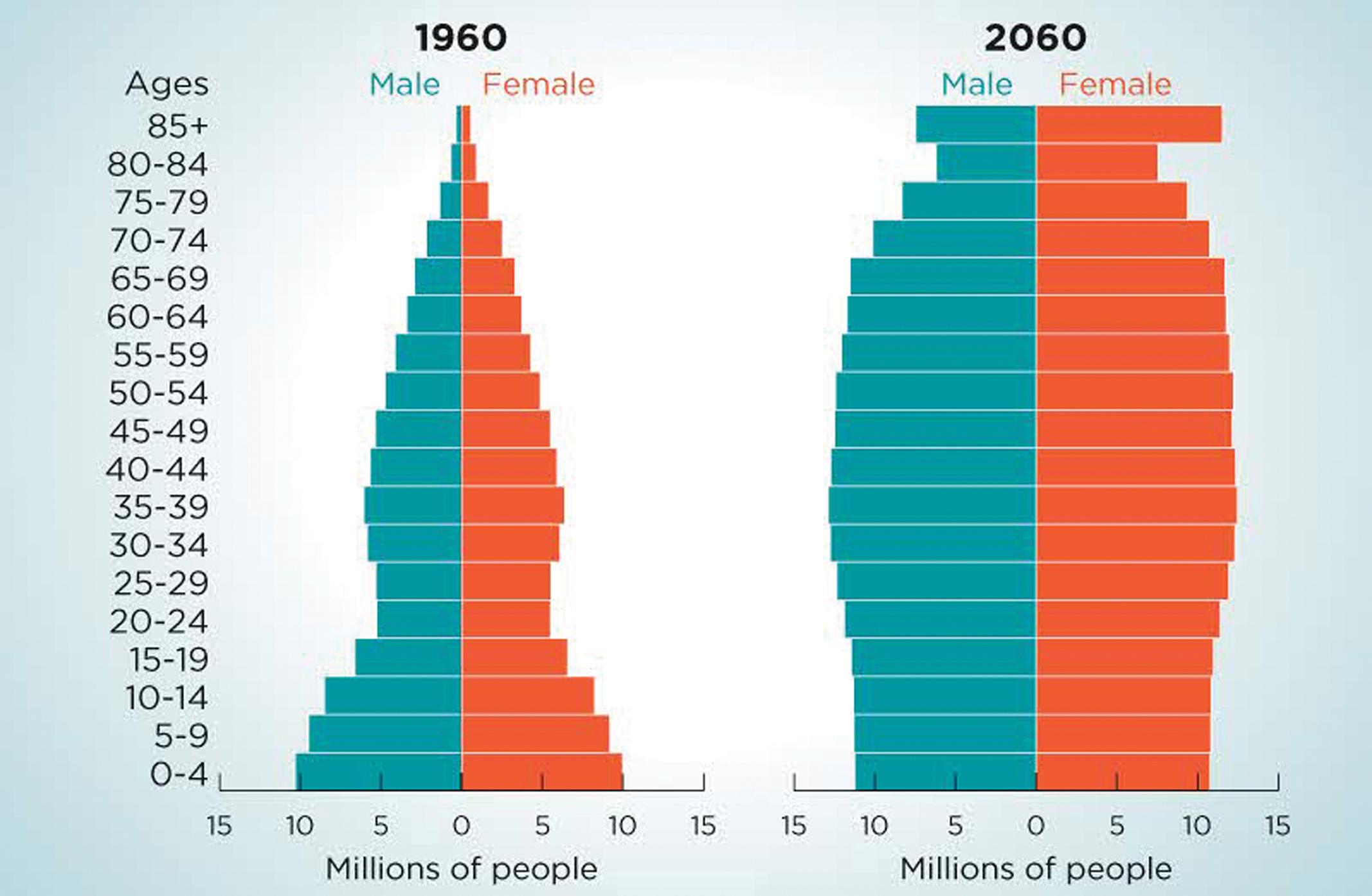
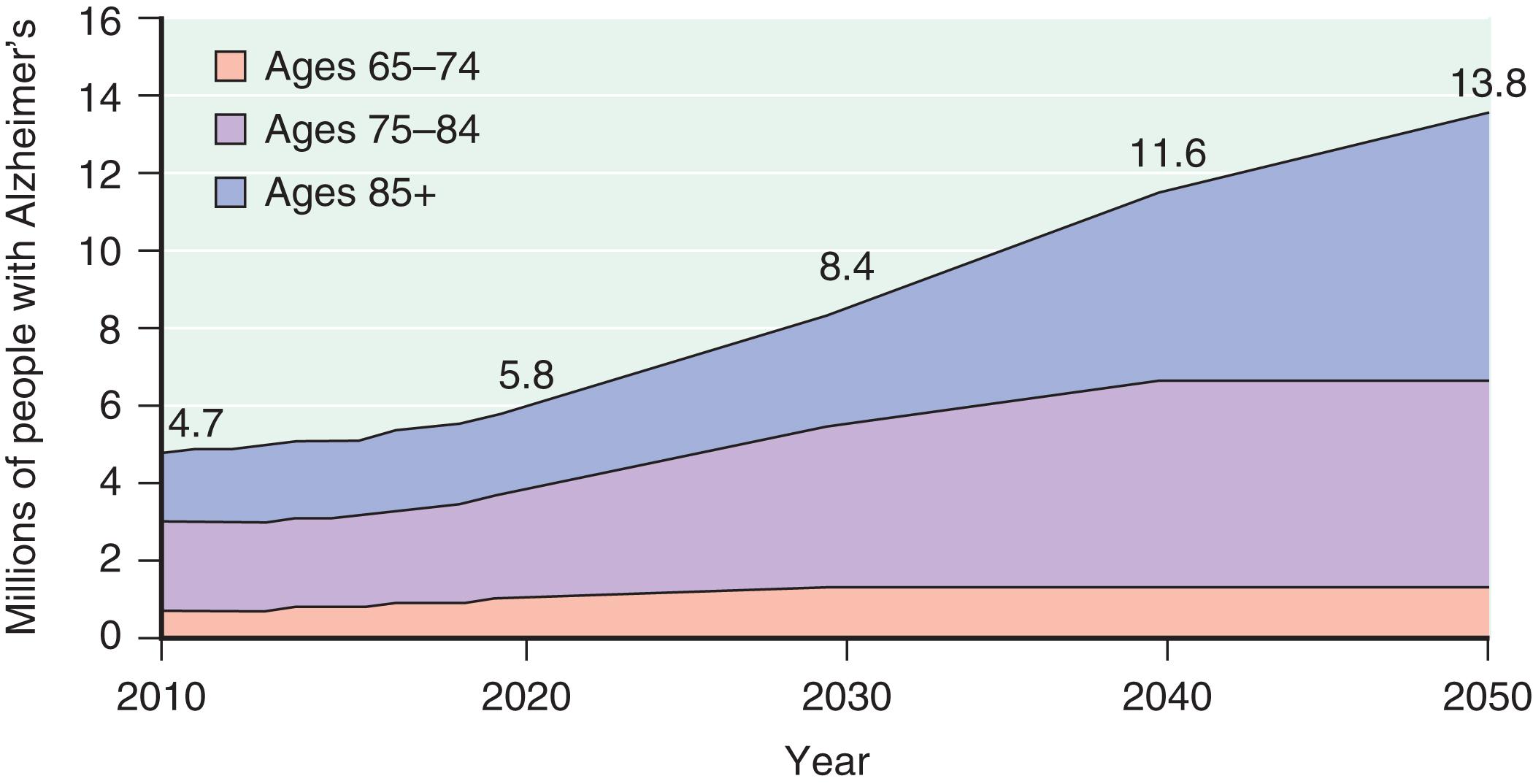
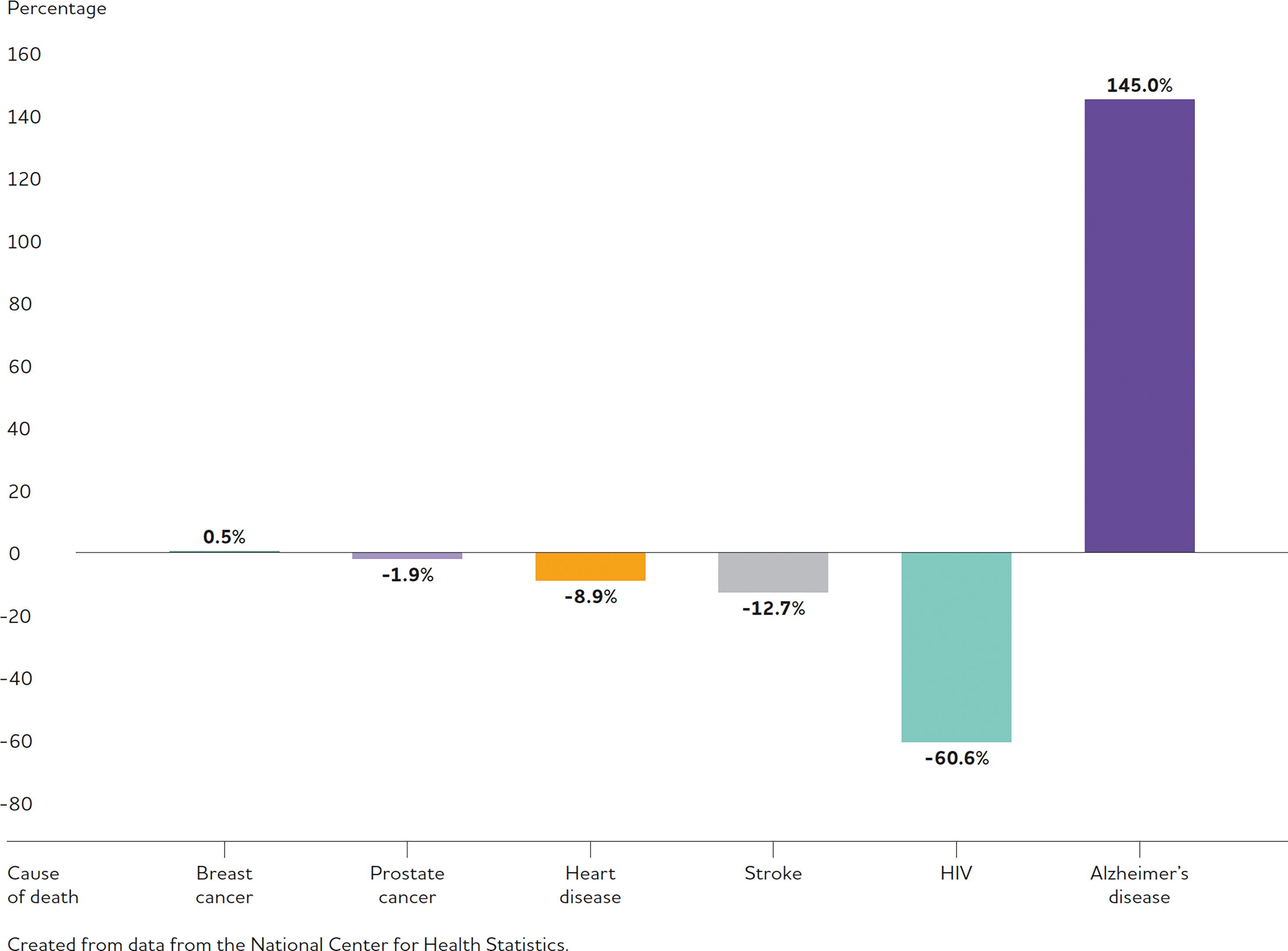
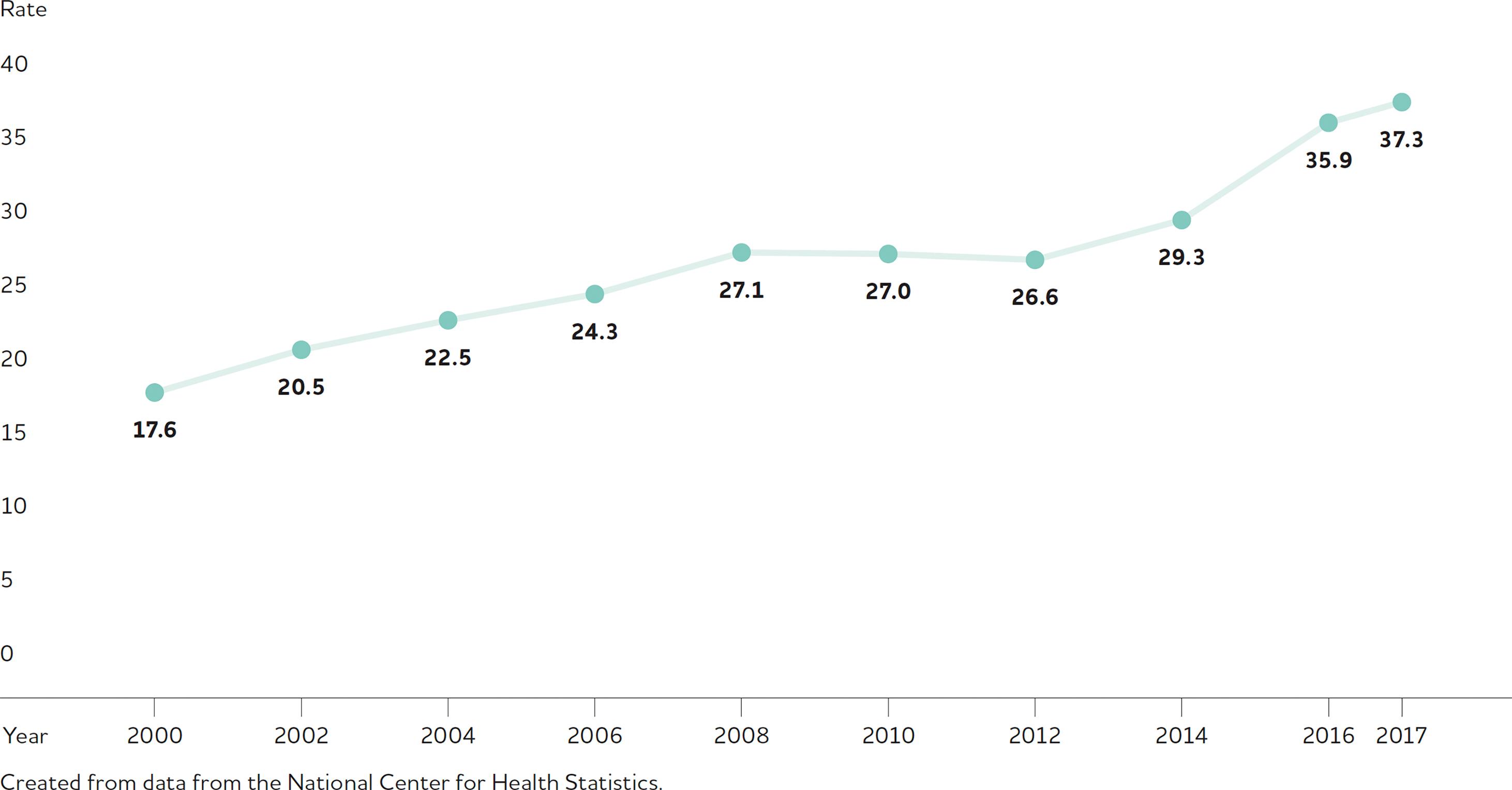
Brain weight is typically reduced in Alzheimer’s disease by 100 to 200 grams. Examination of the surface of the brain reveals cortical atrophy of the temporal, parietal, and frontal lobes, as well as the hippocampus ( Fig. 4.5 ). The ventricular system becomes enlarged ( Fig. 4.6 ). The occipital lobes, along with primary sensory and motor cortices, are usually preserved. Microscopically, Alzheimer’s pathology consists of two main features, senile plaques and neurofibrillary tangles ( Figs. 4.7 and 4.8 ). Additional microscopic features include selective loss of neurons and synapses, and an increase in the number and activation of astrocytes. Neuropil threads (short, often curly silver-stained fibers) also accumulate in the neocortex. The exact relationship between Aβ, plaques, tangles, cognitive impairment, and disease progression is an active area of research.
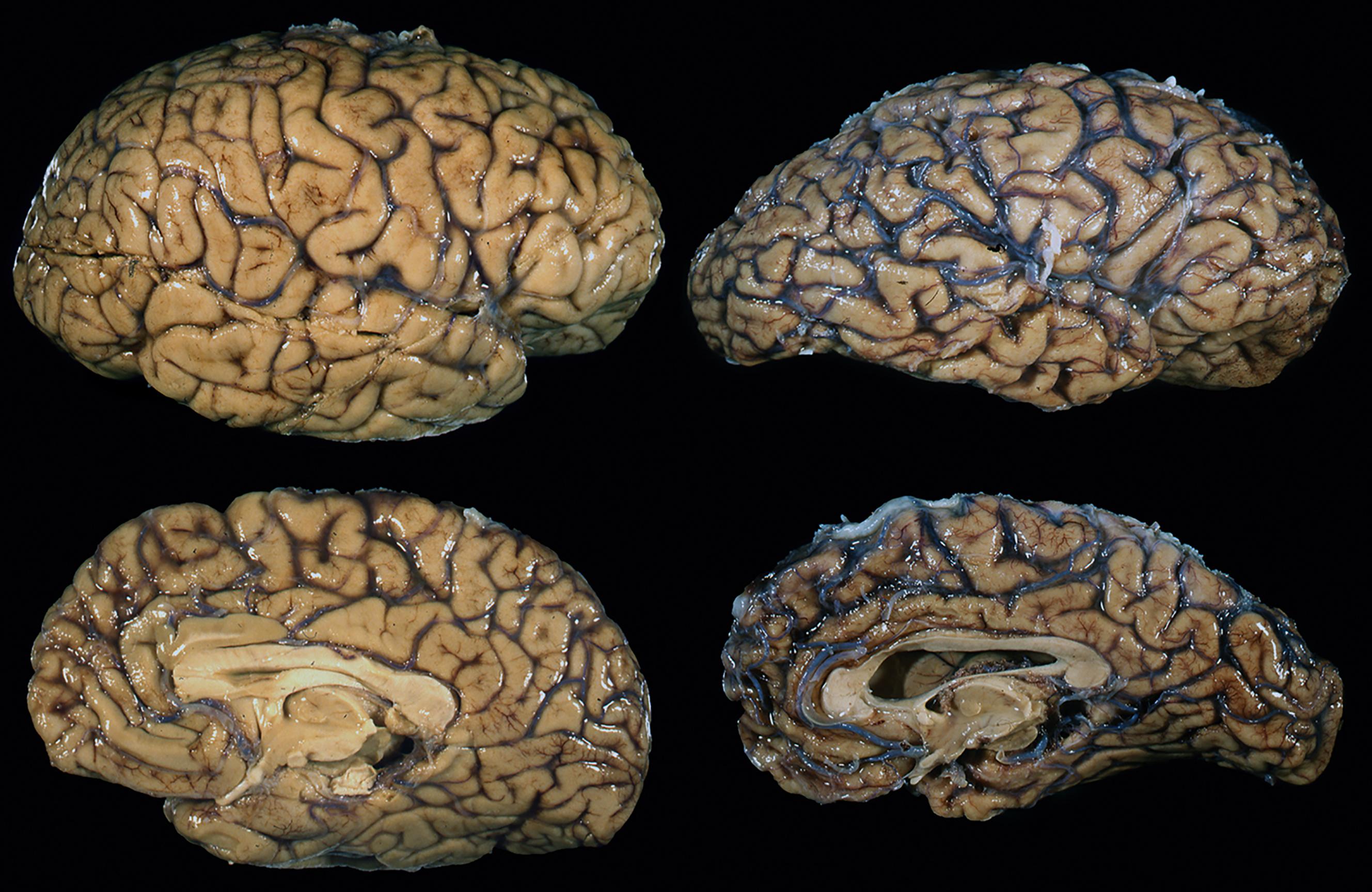
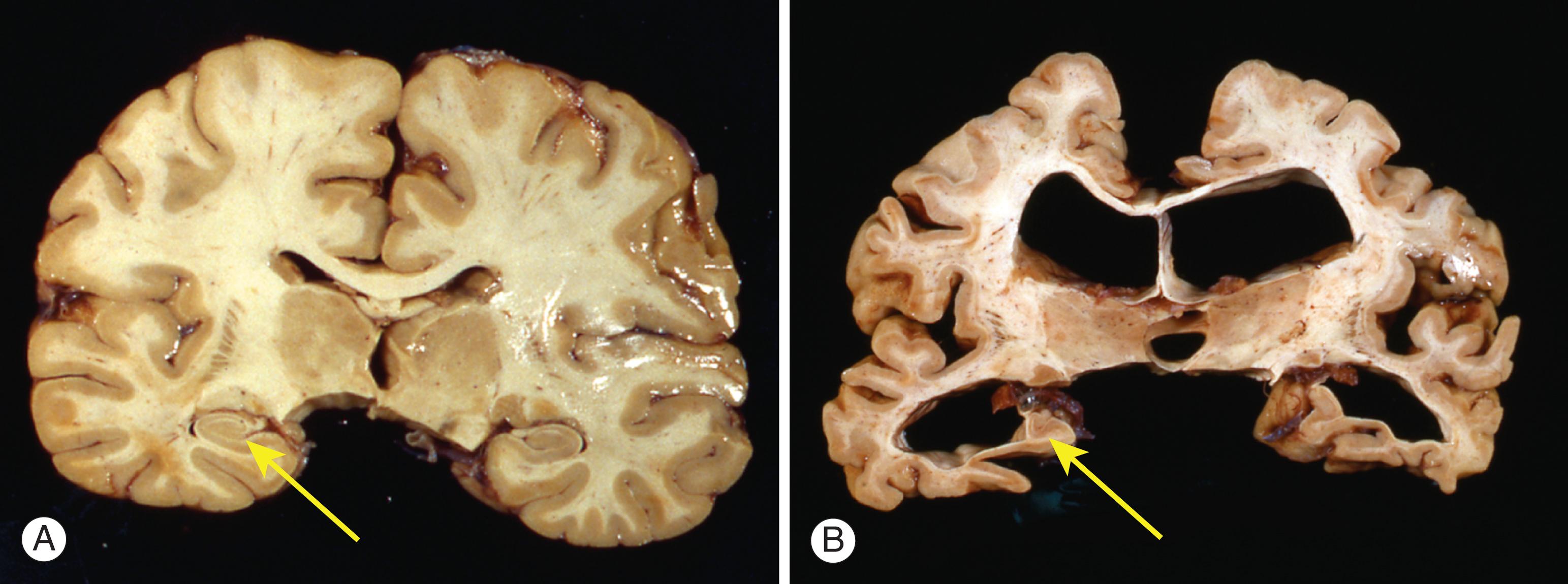

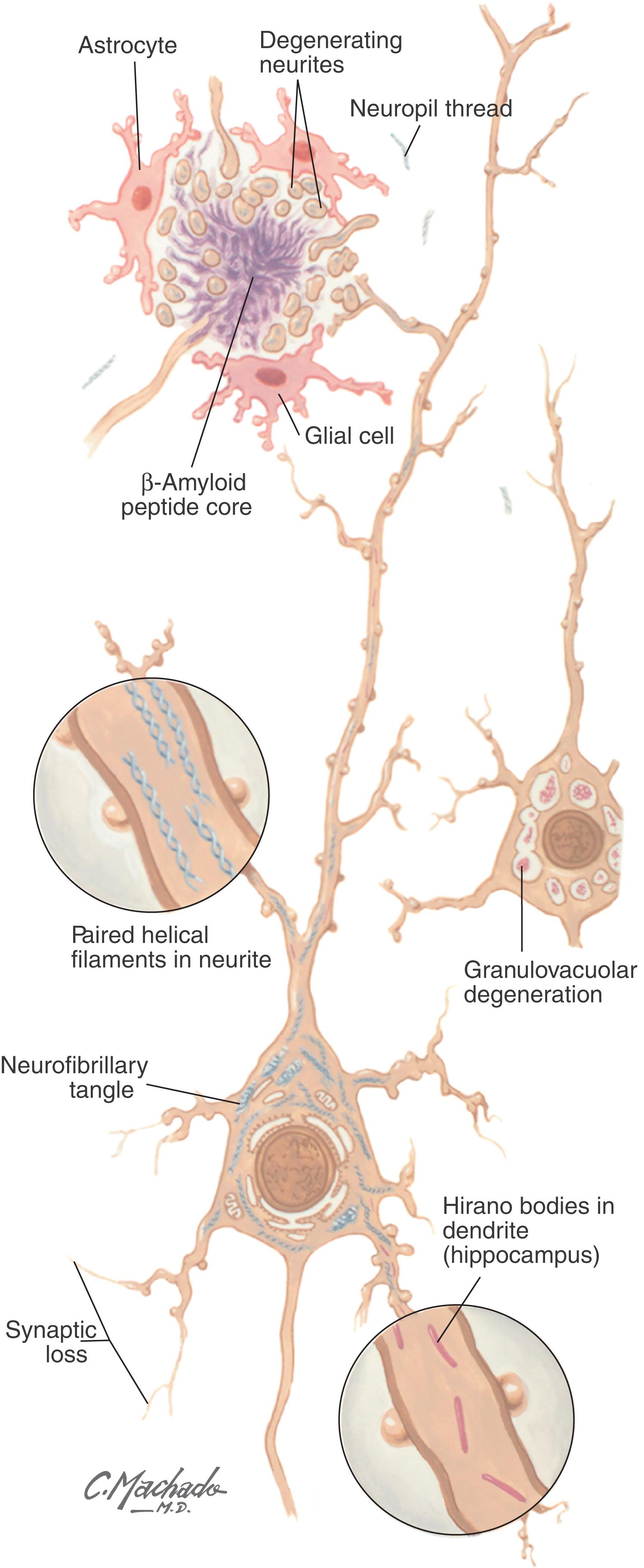
Senile plaques contain a specific type of amyloid, often referred to as β-amyloid or as “Aβ.” (Note that the amyloid in Alzheimer’s disease is not related to the amyloid in systemic amyloidoses.) Aβ is a 40- or 42-amino acid peptide that is a fragment of a larger, membrane-spanning glycoprotein known as the amyloid precursor protein or APP. The normal function of Aβ is unclear, although it may be part of the brain’s immune system ( ). Up to 50% of the Aβ found in plaques is Aβ42. Senile plaques are extracellular structures that are composed of Aβ, dystrophic neuritic processes (axons and dendrites), astrocytes and their processes, and microglial cells (see Fig. 4.8 ). When axons and dendrites are disrupted, the communication between neurons becomes impaired. When microglial cells attempt to remove amyloid and remnants of axons and dendrites, an inflammatory reaction can start causing more damage. Under light microscopy senile plaques appear to have a fluffy central core with surrounding thick irregular processes ( Fig. 4.9 ). Various classifications of senile plaques have been proposed, including diffuse and neuritic types. Neuritic plaques are associated with the destruction of axons and dendrites of neurons. Diffuse plaques do not disrupt these neuronal processes, but are thought to be the precursor of neuritic plaques.
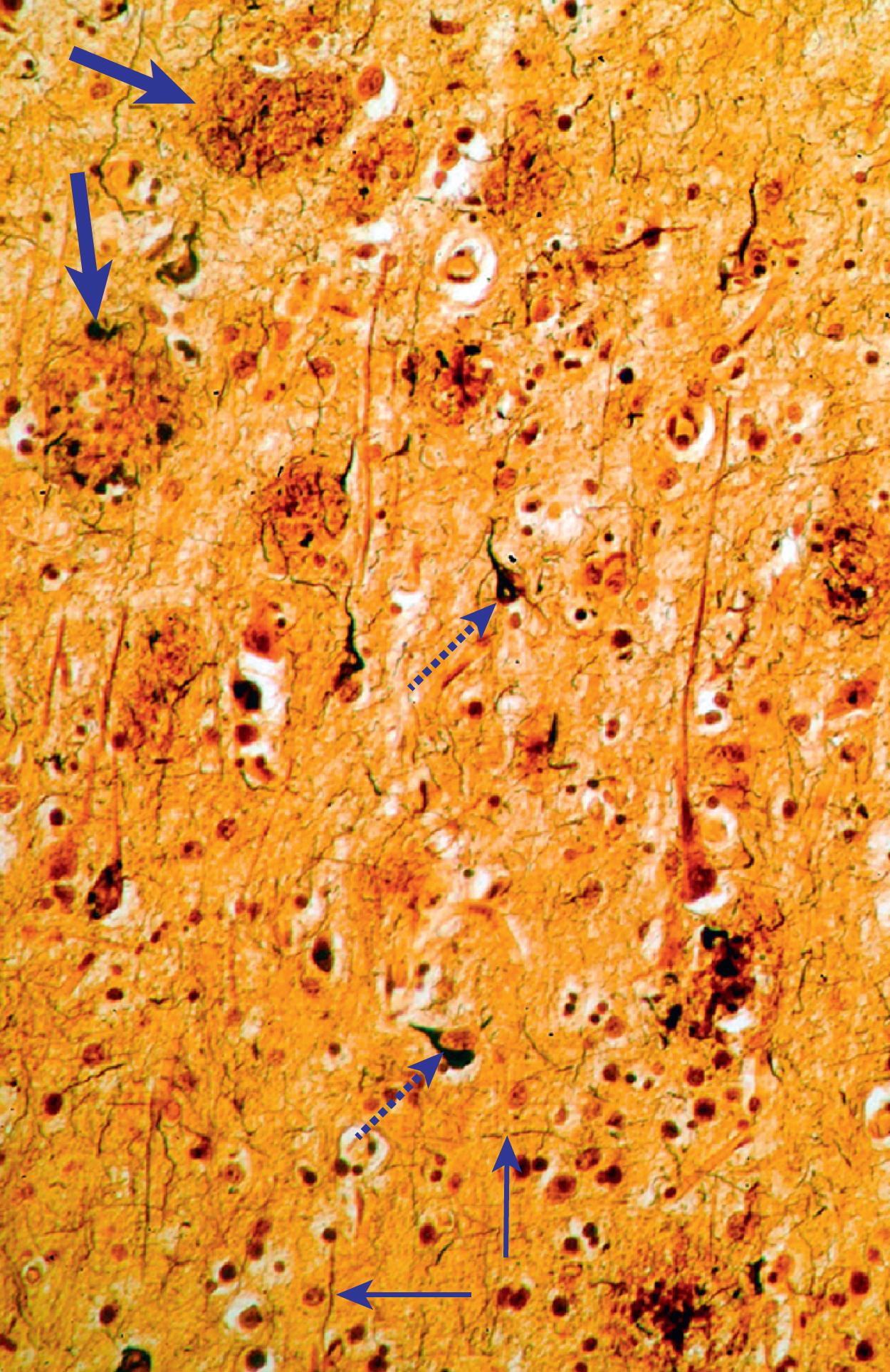
Neurofibrillary tangles are intraneuronal cytoplasmic structures that are composed of paired filaments with a regular helical periodicity (see Fig. 4.8 ). Neurofibrillary tangles appear to be composed primarily of a hyperphosphorylated form of the microtubule-associated protein tau. Microtubules are one of the three major constituents of the neuronal cytoskeleton, an infrastructural element of neurons that participate in functions such as axonal transport and maintenance of the structural integrity of the cell. Among other roles, tau and other microtubule-associated proteins stabilize the microtubule assembly (think of tau as the support beams or rivets for this system). Although neurofibrillary tangles begin as intracytoplasmic structures, they may remain behind after the neuron dies, forming “ghost” or “tombstone” tangles in the neuropil. Under the microscope neurofibrillary tangles can look like skeins of yarn (see Fig. 4.9 ).
A deficit in acetylcholine is the most consistently found alteration of brain chemistry in Alzheimer’s disease. Early in the disease there is a loss of choline acetyltransferase and reduced high-affinity choline uptake and acetylcholine synthesis ( ). Studies have shown a correlation between the loss of choline acetyltransferase and impairment of cognition ( ). These data have led to the cholinergic hypothesis of Alzheimer’s disease that, in turn, has led to the development of acetylcholinesterase inhibitor therapies to treat this disorder (see Chapter 19 ). Other studies have shown that, in addition to acetylcholine, many other neurotransmitters also become disrupted as the disease progresses, including norepinephrine, serotonin, glutamate, and dopamine ( Fig. 4.10 ).
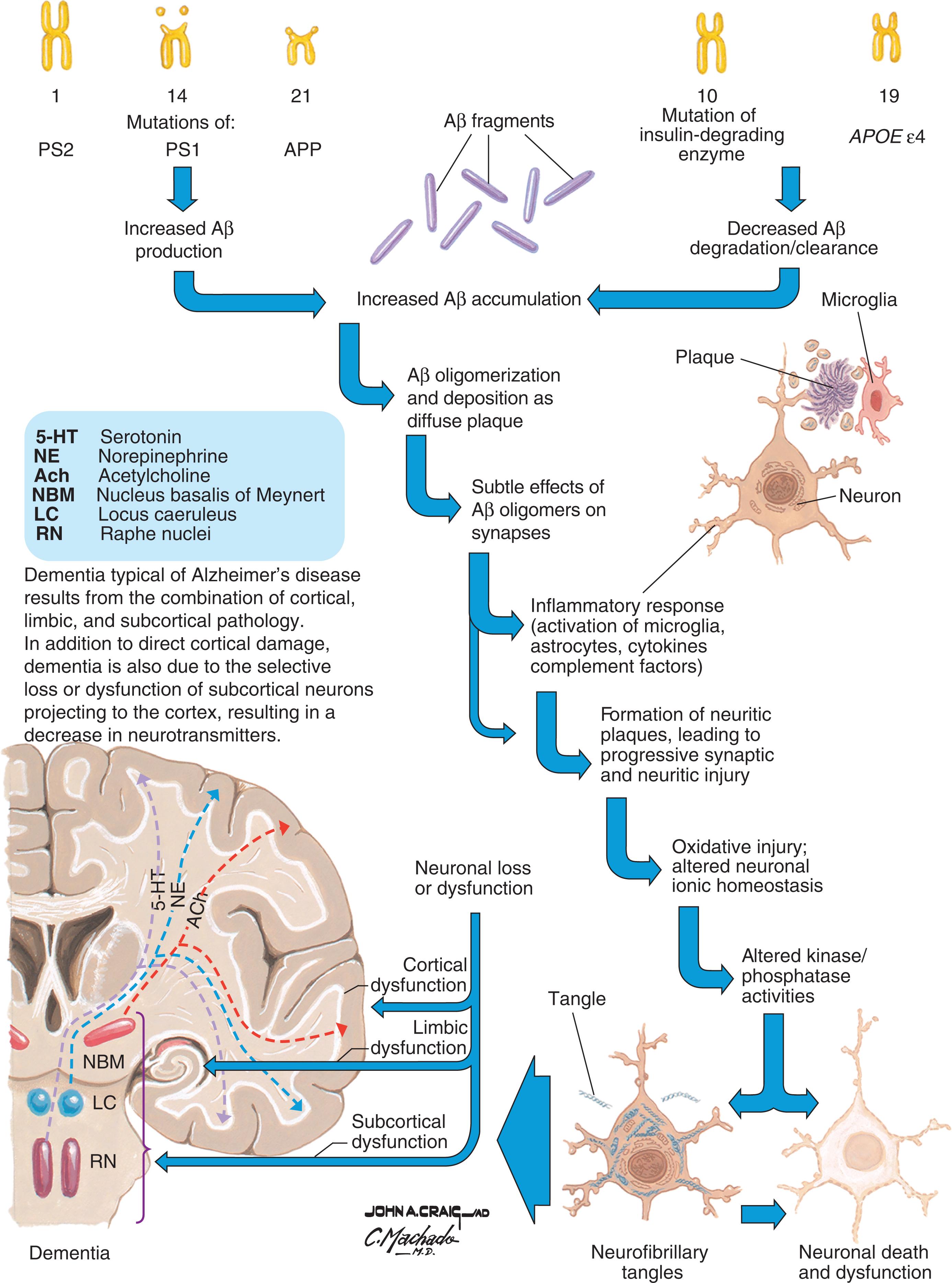
There are several different clinical diagnostic criteria that are used for Alzheimer’s disease. The two most common are from the Diagnostic and Statistical Manual of Mental Disorders (DSM; current edition 5) and the National Institute on Aging–Alzheimer’s Association Criteria ( ) ( Boxes 4.1–4.3 ). Each has provided criteria for Alzheimer’s disease dementia (called major neurocognitive disorder due to Alzheimer’s disease in DSM-5) and mild cognitive impairment due to Alzheimer’s disease (called mild neurocognitive disorder due to Alzheimer’s disease in DSM-5).
The criteria are met for major or mild neurocognitive disorder.
There is insidious onset and gradual progression of impairment in one or more cognitive domains (for major neurocognitive disorder, at least two domains must be impaired).
Criteria are met for either probable or possible Alzheimer’s disease as follows:
For major neurocognitive disorder:
Probable Alzheimer’s disease is diagnosed if either of the following is present; otherwise possible Alzheimer’s disease should be diagnosed.
Evidence of a causative Alzheimer’s disease genetic mutation from family history or genetic testing.
All three of the following are present:
Clear evidence of decline in memory and learning and at least one other cognitive domain (based on detailed history or serial neuropsychological testing).
Steadily progressive, gradual decline in cognition, without extended plateaus.
No evidence of mixed etiology (i.e., absence of other neurodegenerative or cerebrovascular disease, or another neurological, mental, or systemic disease or condition likely contributing to cognitive decline).
For mild neurocognitive disorder:
Probable Alzheimer’s disease is diagnosed if there is evidence of a causative Alzheimer’s disease genetic mutation from either genetic testing or family history.
Possible Alzheimer’s disease is diagnosed if there is no evidence of a causative Alzheimer’s disease genetic mutation from either genetic testing or family history, and all three of the following are present:
Clear evidence of decline in memory and learning.
Steadily progressive, gradual decline in cognition, without extended plateaus.
No evidence of mixed etiology (i.e., absence of other neurodegenerative or cerebrovascular disease, or another neurological or systemic disease or condition likely contributing to cognitive decline).
The disturbance is not better explained by cerebrovascular disease, another neurodegenerative disease, the effects of a substance, or another mental, neurological, or systemic disorder.
Probable Alzheimer’s disease dementia is diagnosed when the patient:
Meets NIA-AA criteria for dementia described in Chapter 3 , and in addition, has the following characteristics:
Insidious onset. Symptoms have a gradual onset over months to years, not sudden over hours or days;
Clear-cut history of worsening of cognition by report or observation; and
The initial and most prominent cognitive deficits are evident on history and examination in one of the following categories.
Amnestic presentation: It is the most common syndromic presentation of Alzheimer’s disease dementia. The deficits should include impairment in learning and recall of recently learned information. There should also be evidence of cognitive dysfunction in at least one other cognitive domain, as defined in the NIA-AA criteria for dementia described in Chapter 3 .
Nonamnestic presentations:
Language presentation: The most prominent deficits are in word-finding, but deficits in other cognitive domains should be present.
Visuospatial presentation: The most prominent deficits are in spatial cognition, including object agnosia, impaired face recognition, simultanagnosia, and alexia. Deficits in other cognitive domains should be present.
Executive dysfunction: The most prominent deficits are impaired reasoning, judgment, and problem solving. Deficits in other cognitive domains should be present.
The diagnosis of probable Alzheimer’s disease dementia should not be applied when there is evidence of (a) substantial concomitant cerebrovascular disease, defined by a history of a stroke temporally related to the onset or worsening of cognitive impairment; or the presence of multiple or extensive infarcts or severe white matter hyperintensity burden; or (b) core features of dementia with Lewy bodies other than dementia itself; or (c) prominent features of behavioral variant frontotemporal dementia; or (d) prominent features of semantic variant primary progressive aphasia or nonfluent/agrammatic variant primary progressive aphasia; or (e) evidence for another concurrent, active neurological disease, or a non-neurological medical comorbidity or use of medication that could have a substantial effect on cognition.
Establish clinical and cognitive criteria for mild cognitive impairment
Cognitive concern reflecting a change in cognition reported by patient or informant or clinician (i.e., historical or observed evidence of decline over time)
Objective evidence of impairment in one or more cognitive domains, typically including memory (i.e., formal or bedside testing to establish level of cognitive function in multiple domains)
Preservation of independence in functional abilities
Not demented.
Examine etiology of mild cognitive impairment due to Alzheimer’s disease pathophysiological process
Rule out vascular, traumatic, medical causes of cognitive decline, where possible
Provide evidence of longitudinal decline in cognition, when feasible
Report history consistent with Alzheimer’s disease genetic factors, where relevant.
For Alzheimer’s disease dementia, common elements of each are:
the presence of dementia (see Chapter 3 )
deficits in two or more cognitive areas
insidious onset and a gradually progressive decline
no evidence of another etiology that could substantial contribute to the dementia.
For mild cognitive impairment due to Alzheimer’s disease, the common elements of each are:
the presence of mild cognitive impairment (see Chapter 3 )
deficits in one or more cognitive areas, including memory (for DSM-5) or typically including memory (for NIA-AA)
gradual onset and progression
no evidence of another etiology that could substantially contribute to the mild cognitive impairment.
There is also a more recent National Institute on Aging–Alzheimer’s Association research framework ( ) that offers clarification and simplification of several aspects of the 2011 criteria. First, as described in Chapter 3 , they provide new definitions for cognitively unimpaired, mild cognitive impairment, and dementia due to any cause. Second, they separate Alzheimer’s disease as a pathologic entity from the Alzheimer’s clinical syndrome. Other terms previously used for Alzheimer’s clinical syndrome include “progressive amnestic dysfunction” ( ), “probable Alzheimer’s dementia,” and “dementia of the Alzheimer’s type.” (We prefer the term progressive amnestic dysfunction because it is simple, self-explanatory, and less likely to be confused with the pathologic entity of Alzheimer’s disease.) Third, they provide a new definition of biomarkers to help identify when Alzheimer’s disease pathology is actually present (which requires evidence of both amyloid and phosphorylated tau deposition in the brain), as well as when neurodegeneration is present ( Box 4.4 ). This framework can be used to simplify the cumbersome nomenclature of the 2011 criteria ( ). In this chapter we have provided the 2011 core criteria for probable Alzheimer’s disease dementia (see Box 4.2 ) and mild cognitive impairment due to Alzheimer’s disease (see Box 4.3 ) because of their clinical utility, as well as the 2018 syndromal cognitive stage and biomarker profile table ( Table 4.1 )—rather than the somewhat confusing 2011 definitions of possible Alzheimer’s disease and probable Alzheimer’s disease dementia with increased level of certainty.
A: Aggregated Aβ or associated pathologic state
Low CSF Aβ 42 or Aβ 42 /Aβ 40 ratio
Positive amyloid PET
T: Aggregated tau (neurofibrillary tangles) or associated pathologic state
Elevated CSF phosphorylated tau
Positive tau PET
(N): Neurodegeneration or neuronal injury
Atrophy on anatomic MRI
Decreased metabolism on 18 flurodeoxyglucose (FDG) PET
Elevated CSF total tau
| Syndromal Cognitive Stage | |||
|---|---|---|---|
| Biomarker Profile | Cognitively Unimpaired | Mild Cognitive Impairment | Dementia |
| A + T − (N) − | Preclinical Alzheimer’s pathologic change | Alzheimer’s pathologic change with mild cognitive impairment (MCI) | Alzheimer’s pathologic change with dementia |
| A + T − (N) + | Alzheimer’s and concomitant suspected non-Alzheimer’s pathologic change, cognitively unimpaired | Alzheimer’s and concomitant suspected non-Alzheimer’s pathologic change with MCI | Alzheimer’s and concomitant suspected non-Alzheimer’s pathologic change with dementia |
| A + T + (N) − | Preclinical Alzheimer’s disease | Alzheimer’s disease with MCI | Alzheimer’s disease with dementia |
| A + T + (N) + | |||
Age is the primary risk factor for Alzheimer’s disease. Other risk factors include family history of Alzheimer’s disease, female gender, few years of education, medical factors (including strokes, elevated plasma homocysteine levels, obstructive sleep apnea, and other risk factors for cerebrovascular disease), lifestyle choices, and genetic factors, particularly certain allelic forms of the gene coding for apolipoprotein E (APOE). Head injury may also be a risk factor for Alzheimer’s disease in addition to dementia with Lewy bodies (see Chapter 8 ) and chronic traumatic encephalopathy (CTE) (see Chapter 15 ). Late-onset depression has been associated with increased risk of cognitive decline, although depression may be an early sign of Alzheimer’s disease (see Chapter 17 ). In addition, as many as 90% of individuals with trisomy 21 (Down’s syndrome) who die over the age of 30 show Alzheimer’s disease pathology in their brains, suggesting that it may be found in all older individuals with Down’s syndrome. Several studies have suggested that having high premorbid intelligence (often correlated with many years of education) may be protective, in addition to healthy lifestyle choices such as physical activity, Mediterranean-style diet, and social engagement (see Chapter 22 ). Some possible disease-modulating factors have shown mixed results: some studies show a beneficial effect whereas other studies show either no effect or a detrimental effect. The factors with mixed results include estrogen supplementation, certain nonsteroidal antiinflammatory drugs (NSAIDs), certain statin-based lipid-lowering agents, and smoking. Note that intervention trials with NSAIDs and statins have been negative to date (see Chapter 21 ). One reason that NSAIDs have been suspected as possibly being protective is that inflammation has been postulated as playing an important role in the pathophysiology of Alzheimer’s disease (see Fig. 4.10 ). Lastly, it should also be noted that some of these factors—including but not limited to obesity, diabetes, hypertension, and cardiac disease—may increase the risk of progressive amnestic dysfunction (Alzheimer’s clinical syndrome), but not Alzheimer’s disease pathology ( ). Nonetheless, we certainly want to encourage our patients to reduce their risk of dementia, whether from Alzheimer’s disease or cerebrovascular pathology. As mentioned in Chapter 3 , most clinical dementia results from mixed pathology,
Given that age is the primary risk factor for Alzheimer’s disease and that such a high percentage of older adults develop the disease, it is reasonable to wonder whether Alzheimer’s disease is simply part of the normal aging process. We do not believe that this idea is correct. Alzheimer’s disease is simply more common in aging, as are hypertension, type 2 diabetes, and cancer. At least three lines of evidence support the idea that Alzheimer’s is a distinct age-related, but not age-determined, disease. First, many individuals live into their 80s and 90s without evidence of significant cognitive impairment, as do roughly half of centenarians. Second, patients with the accelerated aging disorder progeria do not develop dementia. Third, although autopsies may show some Alzheimer’s pathology in the brains of normal older adults without cognitive impairment, the density of these neurofibrillary tangles and senile plaques is markedly lower in these individuals than in those with clinically diagnosed Alzheimer’s disease.
Specific mutations on chromosomes 21, 14, and 1 have been associated with early-onset familial Alzheimer’s disease. These patients with autosomal-dominant early-onset disease are relatively rare, and are typically easy to diagnose by family history. Patients with early-onset disease present clinically in their 40s and 50s, and usually family members can detect subtle changes years before clinical onset. The genetics of late-onset Alzheimer’s disease has been harder to elucidate. The strongest genetic risk factor for late-onset Alzheimer’s disease is the APOE allele. Relative to having an APOE ε3 allele, patients having an APOE ε4 allele are at increased risk of developing Alzheimer’s disease (see Fig. 4.10 and 4.11 ).
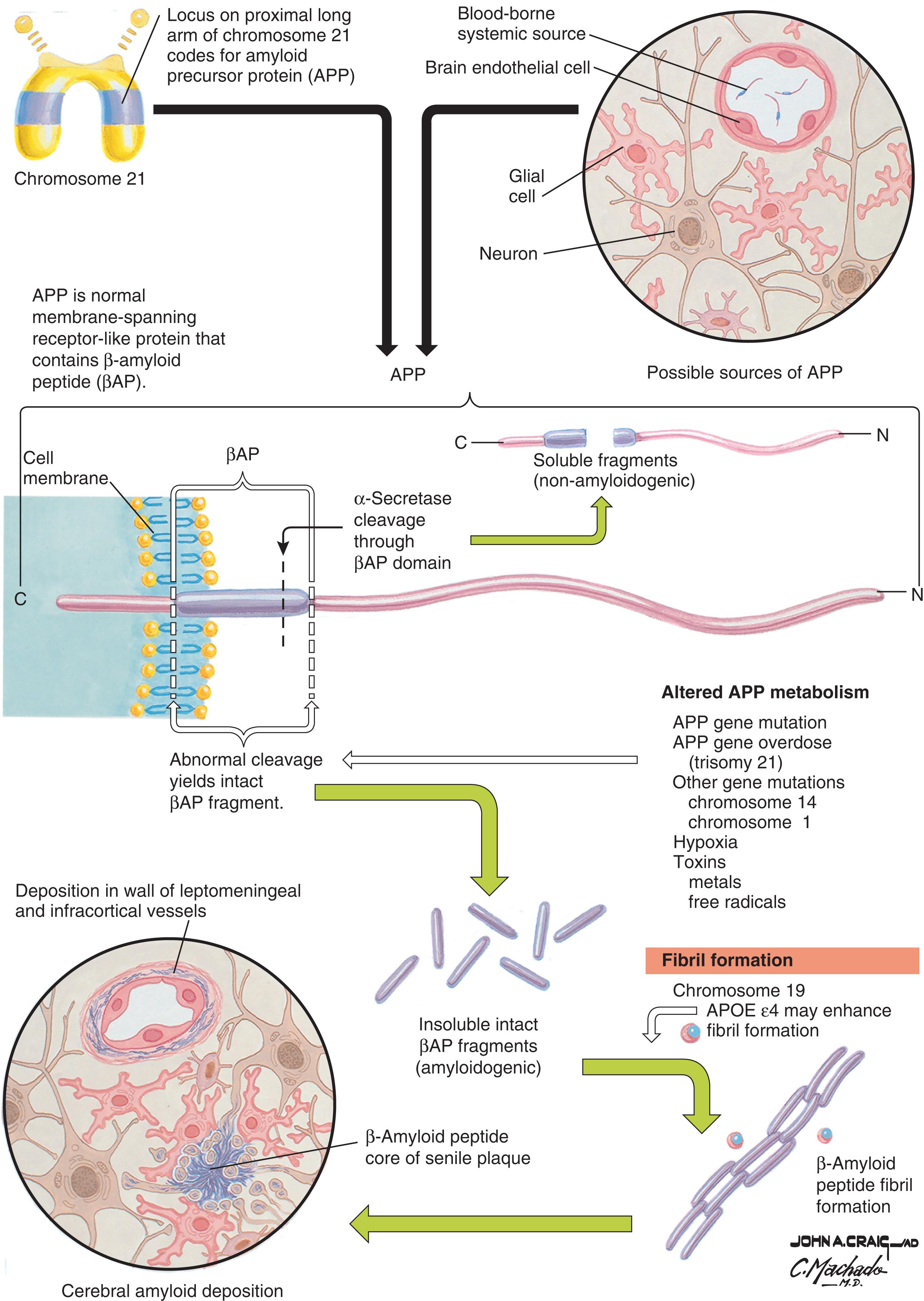
APOE is a major component of lipoproteins and has many normal functions, including lipid transport. The gene coding for APOE is on chromosome 19. The three common isoforms of APOE are APOE-2, APOE-3, and APOE-4, coded for by alleles ε2, ε3, and ε4, respectively. APOE ε3 is the most common allele in the population, with a frequency of about 78%. Patients with familial and sporadic late-onset Alzheimer’s disease (onset after age 55 years) have an approximately 3-fold increased likelihood of having an APOE ε4 allele. Conversely, the likelihood of having an APOE ε2 allele is lower than expected by allelic frequencies alone. Numerous studies have confirmed these findings, which suggest that APOE ε4 is a risk factor for developing Alzheimer’s disease, whereas APOE ε2 is a protective factor. In addition to conferring increased risk of developing Alzheimer’s disease, having an APOE ε4 allele also lowers the age of onset of the disease compared with those without an ε4 allele who develop it ( ). The majority of studies suggest that the course of Alzheimer’s disease is not affected by the presence of an ε4 allele, although a few studies have disagreed with this finding. Neuropathologically, in patients with Alzheimer’s disease there is more Aβ deposition in the brains of those with an ε4 allele than in those who have only ε3 alleles.
Should APOE genotyping be ordered routinely? Given the wealth of clinical and basic science data on the relationship between APOE and Alzheimer’s disease, the question arises as to whether APOE genotyping should be performed routinely. We would argue that, in general, it is not clinically useful. Although carrying an APOE ε4 allele is a significant risk factor, it is neither necessary nor sufficient to cause Alzheimer’s disease. First, approximately half of patients with Alzheimer’s disease do not carry an APOE ε4 allele. Second, up to one-quarter of patients with non-Alzheimer’s dementias carry an ε4 allele. Third, 10% to 19% of healthy older adults carry one or two ε4 alleles. Fourth, because APOE alleles are present from birth, APOE genotyping cannot be used to distinguish mild Alzheimer’s disease from normal aging. Thus using the APOE ε4 allele as a marker of Alzheimer’s disease would result in huge numbers of both false positives and false negatives. Although it can be helpful in research, we do not recommend APOE genotyping in clinical practice.
A family history of Alzheimer’s disease in a first-degree relative increases the risk of developing Alzheimer’s disease between 2-fold and 4-fold ( ), and more distant family relatives with Alzheimer’s also increase one’s risk ( ). Knowledge of this increase in risk causes many middle-aged children of patients with Alzheimer’s disease to become apprehensive that they, too, will develop this disorder. We generally point out to these family members that, although the risk of Alzheimer’s disease is increased with a family history of the disorder, Alzheimer’s disease is unfortunately extremely common as we age, such that everyone is at risk for the disorder, with or without a family history. More importantly, if the overall risk of Alzheimer’s disease is about 2.5% between ages 65 and 70, the risk without a family history is probably around 1.5% and the risk with a family history is probably around 3%. Thus, although the relative risk may be doubled, the overall risk is still quite small. See Chapter 30 for more on this important topic.
As mentioned, approximately two-thirds of patients with Alzheimer’s disease are women, with the overall lifetime risk being 11.6% for men and 21.1% for women. This finding cannot solely be explained by the longer life expectancy of women resulting in larger numbers of women living into old age. Factors that have been suggested to explain this phenomenon include hormonal differences between men and women, different lifelong environmental exposures, and differences in years of education. More research is needed on this important topic.
It has been suggested that an increased number of years of education may reduce the risk of Alzheimer’s disease, possibly by creating a “cognitive reserve” or a higher mental threshold that delays the onset of clinical symptoms. High educational attainment may also allow patients to compensate for some memory loss (by using memorization strategies, for example), disguising their symptoms and making diagnosis more challenging. Several studies suggest that low educational attainment is a risk factor for Alzheimer’s disease: one study found that an uneducated person over the age of 75 years is twice as likely to suffer dementia as is a person who has completed the 8th grade or higher. In another study, low linguistic ability early in life predicted poor cognitive function and Alzheimer’s disease in late life ( ). In the Framingham Heart Disease Study, however, low educational attainment was not found to be a significant risk factor for Alzheimer’s disease (although it was for vascular dementia) ( ). Overall, we do consider education to be an important factor when considering a patient’s risk of Alzheimer’s disease.
Become a Clinical Tree membership for Full access and enjoy Unlimited articles
If you are a member. Log in here